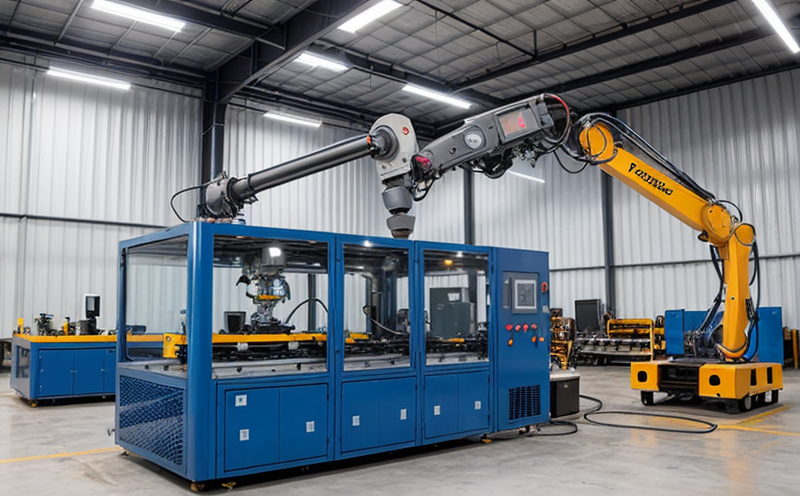ISO 9291 Robotic Arm Speed and Acceleration Testing
The ISO 9291 standard is a critical benchmark in ensuring that robotic arms operate safely and efficiently. This standard is particularly important for industries where precision, repeatability, and reliability are paramount such as automotive manufacturing, aerospace engineering, electronics assembly, and pharmaceutical packaging.
At Eurolab, we offer comprehensive ISO 9291 testing services to verify the speed and acceleration characteristics of robotic arms used in industrial applications. Our team of experts ensures that all tests comply with international standards to provide you with accurate results that meet your quality control requirements. This service is essential for ensuring that robotic systems operate within safe parameters, reducing the risk of accidents or malfunctions.
Testing robotic arm speed involves measuring the time taken by the robot to travel between two points under specified conditions. For acceleration testing, we measure how quickly a robot can reach its maximum velocity from rest or decelerate back to zero velocity after reaching full speed. These tests are conducted using high-precision motion capture systems that provide real-time data on position, velocity, and acceleration.
During specimen preparation for ISO 9291 testing, our technicians ensure that the robotic arm is calibrated according to manufacturer specifications. This ensures accurate readings during the test process. Additionally, we use specialized software tools to analyze the collected data, providing detailed reports on performance metrics including peak velocities achieved, settling times, and smoothness of motion.
Our state-of-the-art facilities are equipped with advanced equipment capable of simulating various operating conditions that robotic arms may encounter in real-world scenarios. This allows us to provide realistic assessments of how your robot will perform under different circumstances. By adhering strictly to ISO 9291 guidelines, we ensure consistent and repeatable results across multiple tests.
Compliance with this standard is crucial for several reasons; it guarantees the safety and reliability of robotic systems by preventing overloads that could lead to equipment failure or injury. Furthermore, meeting these standards enhances your company’s reputation among potential clients who prioritize quality assurance practices.
The importance of ISO 9291 testing cannot be overstated when dealing with complex automated processes where even minor deviations can have significant impacts on production efficiency and product quality. By investing in thorough pre-production validation through rigorous ISO 9291 tests, manufacturers can identify potential issues early on before they become costly problems down the line.
In summary, our ISO 9291 Robotic Arm Speed and Acceleration Testing service offers detailed analysis of robotic arm performance according to industry best practices. With expertise in this field, we help ensure that your industrial robotic systems meet or exceed regulatory requirements while maintaining optimal operational capabilities.
Benefits
- Enhanced Safety: Ensures compliance with international standards reducing the risk of accidents or malfunctions.
- Improved Efficiency: Identifies potential issues early on to maintain optimal operational capabilities.
- Increased Reliability: Provides consistent and repeatable results across multiple tests, enhancing overall product quality.
- Better Reputation: Demonstrates commitment to quality assurance practices that meet or exceed regulatory requirements.
By adhering strictly to ISO 9291 guidelines, you can ensure your robotic systems operate safely and efficiently, thereby improving productivity and reducing downtime. This standard is especially important for industries where precision, repeatability, and reliability are crucial factors in maintaining high-quality output.
Eurolab Advantages
At Eurolab, we pride ourselves on offering unparalleled expertise in industrial robotics testing services. Our team of highly qualified professionals has extensive experience working with various robotic systems across different sectors including automotive manufacturing, aerospace engineering, electronics assembly, and pharmaceutical packaging.
- State-of-the-Art Facilities: Equipped with advanced equipment capable of simulating real-world operating conditions for accurate assessments.
- Precision Calibration: Ensures that robotic arms are calibrated according to manufacturer specifications providing reliable test results.
- Advanced Software Tools: Utilizes specialized software tools to analyze collected data, offering detailed reports on performance metrics including peak velocities achieved, settling times, and smoothness of motion.
- Comprehensive Reporting: Provides thorough documentation outlining all aspects of the testing process along with recommendations for improvement where necessary.
We are committed to helping you achieve compliance with international standards while ensuring that your industrial robotic systems perform at their best. Our goal is not only to meet but also exceed regulatory requirements, providing peace of mind knowing that every aspect of your robotic system has been thoroughly tested and validated.
International Acceptance and Recognition
The ISO 9291 standard for Robotic Arm Speed and Acceleration Testing is widely recognized globally as a key benchmark in ensuring the safety and reliability of industrial robots. This international acceptance underscores its importance across various industries.
- Automotive Manufacturing: Ensures that robotic arms used in car assembly lines meet stringent requirements, contributing to high-quality vehicles with minimal defects.
- Aerospace Engineering: Validates the performance of robots employed in space exploration missions where precision is critical for mission success and crew safety.
- Electronics Assembly: Guarantees that automated assembly processes adhere to exacting tolerances, resulting in high-performance electronic components free from errors.
- Pharmaceutical Packaging: Ensures that packaging machines operate safely and efficiently, maintaining the integrity of pharmaceutical products throughout distribution channels.
The widespread adoption of ISO 9291 demonstrates its value as a comprehensive guide for robotic arm performance evaluation. By aligning with this standard, manufacturers can gain an edge in competitive markets by demonstrating their commitment to quality assurance practices that meet or exceed regulatory requirements.





